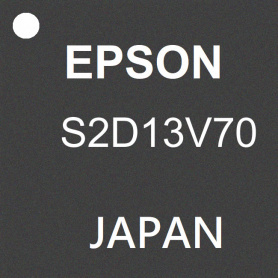Munich, February 13, 2019 – Seiko Epson Corporation (TSE: 6724, „Epson“) has developed a new interface conversion IC for in-vehicle systems that converts eDP (Embedded DisplayPort) video signals to OpenLDI (open LVDS display interface). Samples of the S2D13V70 interface converter are now available. Epson plans to produce 100,000 of these chips per month.
Both eDP and OpenLDI are interface standards for transmitting video signals to displays, but eDP supports higher resolution video and faster speeds than the more widely used OpenLDI. 
With the electrification and automation of automobiles, manufacturers will increasingly require higher resolution displays in in-vehicle systems such as instrument clusters and central information displays. As this trend accelerates, products that support eDP, which can transfer video signals at higher rates, are growing in popularity in ECUs*1 that control in-vehicle displays. On the other hand, in-vehicle displays that support eDP input are not yet mainstream, and since displays are connected using an OpenLDI interface, eDP output signals from an ECU*1 have to be converted to OpenLDI in the development of in-vehicle systems.
To address this issue in in-vehicle systems development, Epson developed the S2D13V70, an interface conversion IC that supports automotive standards. The new product satisfies the strict quality requirements of the automotive industry. It is compliant with AEC-Q100*2 and operates at temperatures up to 105℃.
The conversion IC is also equipped with safety functions required for automotive systems. For example, a CRC function monitors whether video signals output from an ECU are being properly received, and a blank screen function masks the display with a particular image pattern when a problem is detected in the transmission path between an ECU and the conversion IC.
The IC supports the design of dual-display instrument clusters, with a splitter function that splits and outputs video signals on two displays.
Epson is committed to helping its customers improve the performance of their products with solutions that leverage its efficient, compact, and precision technologies.
*1 Electronic control unit (ECU)
Any of various units that use electronic circuity to control a system, usually in a vehicle. Numerous ECUs are found in vehicles, where they control systems such as engines, brakes, and car navigation systems.
*2 AEC-Q100
The Automotive Electronics Council (AEC) is an industry group that creates standards for the reliability and qualification of automotive electronics. It was formed by the „Big Three“ U.S. automobile manufacturers in partnership with major electronic component manufacturers. The AEC standard is a de facto global standard that has been widely adopted as a standard for automotive electronic components.
| Model No. | S2D13V70 |
| Supply voltage | 3.3 V (I/O) |
| Internal core voltage (1.8 V) | |
| Input interface | eDP 1.4a x 2 lanes, up to 2.7 Gbps/lane |
| Output interface | OpenLDI-Tx x 2 channels, up to 154 MHz/ch |
| Display resolution | Up to 1920 x 1200 @ 60 fps |
| Image correction | 8-bit digital gamma LUT + 2-bit dithering |
| Safety functions | SPI connection (checksum with 16-Byte cache) |
| Input pixel clock/Sync signal monitoring | |
| CRC (full screen/register setting/frame comparison) | |
| Blank screen | |
| Automotive standard conformance | AEC-Q100 |
| Operating temperature range | -40 to +105°C |
| Other | System clock: 48 MHz |
| Splitter function | |
| Package | SPI connection (checksum with 16-Byte cache) |
For more info contact an Ineltek office within your area or contact us at info@ineltek.com.